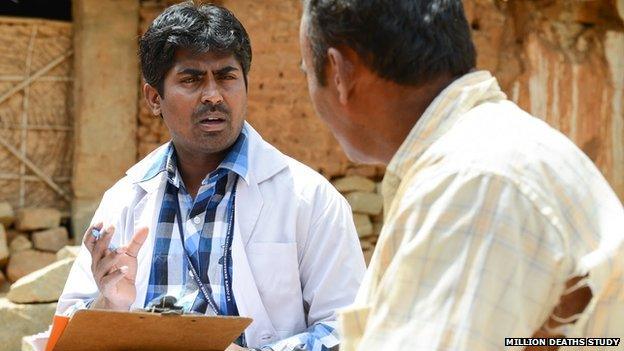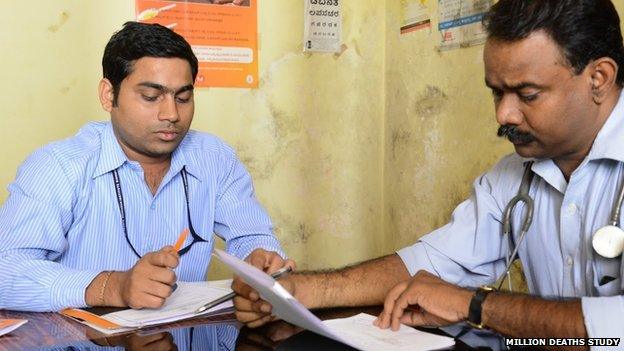The mystery of India's unrecorded deaths
- Published

'Verbal post-mortems' with the dead person's family help build up a picture of the circumstances of death
There are estimated to be around 56m deaths per year according to the World Health Organisation - and it's thought half are not registered - so there is a lot of missing information about what people die of. The Million Deaths Study aims to change that by investigating one million deaths in India - and there have been some surprising discoveries.
In a small house near Bangalore, the loud hum of silk spinning machines in the background, Maniamma relates the details of her husband's death a few months ago.
"The day he died he went to see our daughter who lives in a nearby village. While returning, he had some problems - perhaps a minor heart attack. He got out of the car but couldn't walk."
He died at 6am the following morning.
All the details are recorded by Ashok Kumar, a trained fieldworker, who is carrying out a "verbal post mortem", a technique often used to record causes of death in developing countries.
It's part of a huge study surveying and analysing one million deaths in India.
Hospital deaths 'exception'
Knowing what is killing people is vital - it helps save lives by ensuring public health money is spent on the right things.
In the developed world almost all deaths are registered and the cause of death recorded on an official medical death certificate.
By contrast, most deaths in the developing world go unrecorded, and estimates of the causes of death are generally based on people who die in hospitals and under medical supervision.
But hospital deaths are the exception in India.
"India has about nine million deaths [a year], most of which occur at home and in rural areas" - says Prof Prabhat Jha, who leads the study from the Centre for Global Health Research in Toronto.
The Million Deaths Study (MDS) uses "verbal autopsies" or post-mortems - interviewing those close to the deceased about what happened before their death - as a way of addressing this gap.
The million deaths are chosen from a representative sample of areas across India, and the aim is to ascertain the cause of death in each one.
It's a mammoth task - 60,000 homes per year have been visited over the course of 14 years and they are set to reach the millionth death later this year.
Detective work
Trained interviewers like Ashok Kumar talk to relatives of the deceased to build up a picture of why they died.
He asks about symptoms like unconsciousness, breathlessness or fever leading up to the death, as well as lifestyle questions about smoking, drinking and diet.
The information collected on the field visits will then be passed to two physicians who independently try to decipher the cause of death.
If their conclusions don't tally, the case is passed to a third senior physician to analyse.

Physicians look through the death report to try to decipher the cause of death
By looking into home deaths as well as those under medical supervision, the MDS has built up a more complete picture of what people are dying of.
It also means researchers can tailor disease control by identifying diseases common in one place and rare in another, as well as helping spot emerging epidemics.
Making an impact
After surveying their millionth death, it will take another year or two for all the deaths to be coded and analysed.
But early findings have already made an impact.

The study found a much higher prevalence of malaria deaths in certain states
Controversially, in 2010 the team found malaria deaths in India were 13 times higher than WHO estimates.
The WHO's India Office continues to dispute the high malarial deaths figures. However a spokesman said: "The malaria figures estimated by MDS were unexpectedly high, and justify further investigation."
They suggest malaria is often more difficult to diagnose as a cause of death through verbal autopsy - because fever symptoms are common to other illnesses.
'Understand the living'
Now the study's results are helping fight another major cause of death in India - smoking.
By looking at how the dead person lived, Prof Jha explains, you can understand the living as well as the dead.
"We can study, for example, did the dead person smoke, did they drink, and from that, using simple statistical methods, figure out how many people are dying from smoking in India."
By number crunching the data they found the average male cigarette smoker is losing a decade of life in India.
Prof Jha says their findings helped prompt India's health minister Harsh Vardhan to recommend a 200% tax hike on cigarettes, external for the new government's budget.
In the budget which was announced this week, taxes on cigarettes were raised between 11 and 72%, but the researchers estimate that even this more modest hike could save nearly one million lives.

The Million Deaths Study suggested the average male cigarette smoker loses a decade of life
They also found 50% of people dying from smoking are illiterate - highlighting the importance of India's policy of graphic warnings on cigarette packets.
Dr Sanjay Kinra, a public health expert from the London School of Hygiene and Tropical Medicine who is not involved in the study, believes the MDS will help improve India's health.
"You need lots of information to plan public health policy, and knowing the key cause of death and basic lifestyle factors is a good start."
The ultimate aim, he says, should be for the Indian government to develop a stronger civil registration system to record the details of all deaths - not just a sample as in the Million Deaths Study.
But he adds that knowing the cause of death does have limitations when allocating public health money.
"Not everything that is a disease kills you - and diseases that don't kill you straight away but cause suffering over many years, like diabetes or dementia, also need a lot of resources."
Vivid memory
Prof Jha was inspired to start the project by his grandfather's premature death at the age of 54 in Bihar, India.
"Death isn't avoidable, but early death is, and his death at age 54 was a major trauma on my mother and the extended family."
No-one knew why he'd died young, and years later, as a medical student, Prof Jha went back to his grandfather's village and asked his grandmother what happened.
"She recalled very vividly, 20 years ago, the events: he'd gone to the washroom in the morning, yelled out, collapsed, and his right side wasn't moving. And so on the spot I said: he probably had a stroke."
If his grandmother could recall far-off events so vividly, he reasoned, why couldn't this be applied more widely?
Teaming up with India's Registrar General, who had been keeping death records since 1971, the researchers introduced verbal autopsy into the system so that cause of death and lifestyle information would be recorded at the same time.
Prof Jha is confident that it is a robust way of assessing causes of death.
"In the village in India people will tell you the truth - they'll talk about Aids, they'll talk about sensitive things like suicide, they'll talk about neglect from the government care in a very candid way. And because death is so memorable, people will tell you the details years later."
He doesn't find it depressing looking at deaths all the time - his motto is "study the dead to help the living."
"I'm the first in the world to look at these numbers and see patterns - and I get really excited about them."
What is killing us? is broadcast on on the BBC World Service on Wednesday 16 July at 1930.